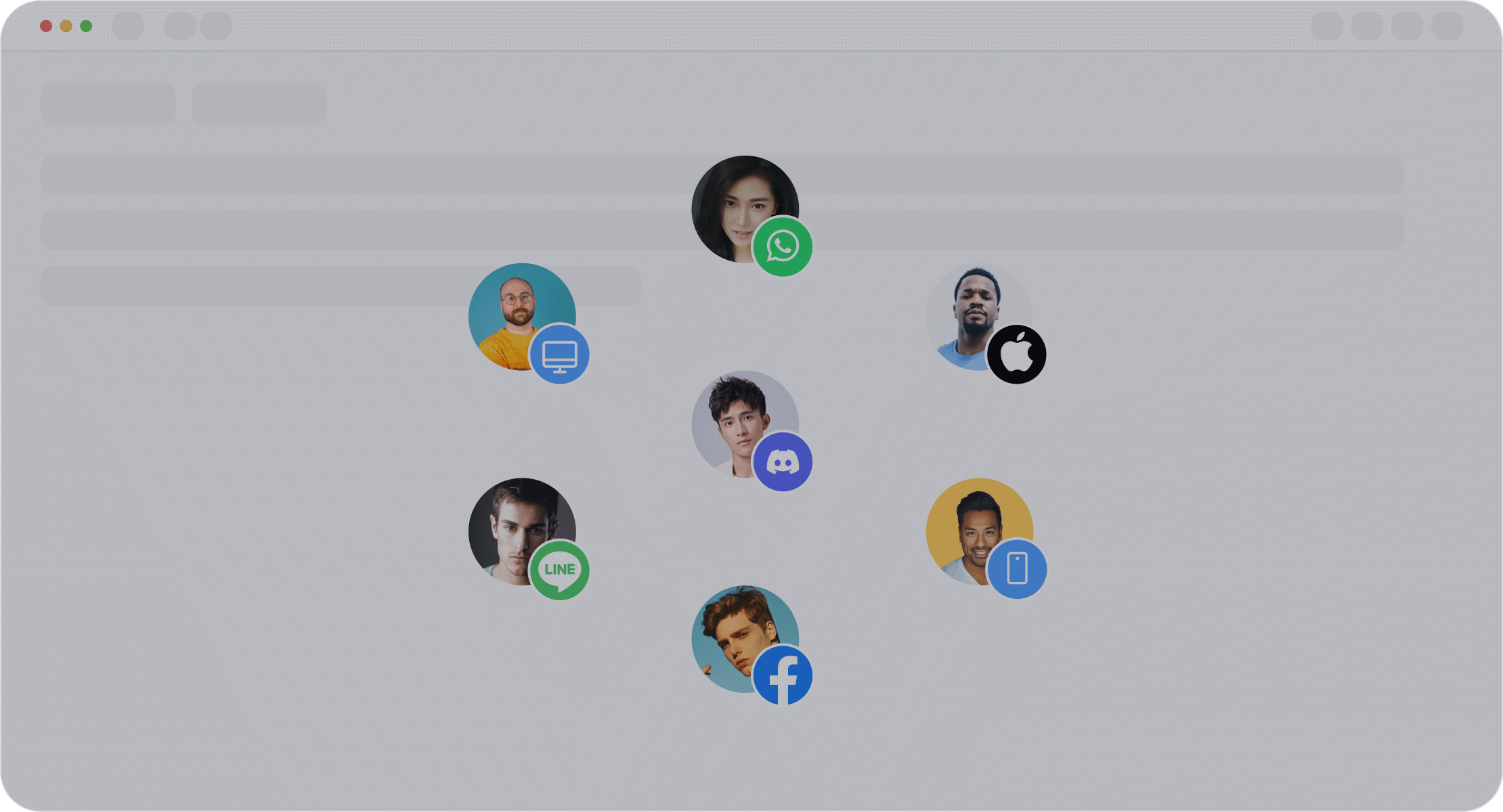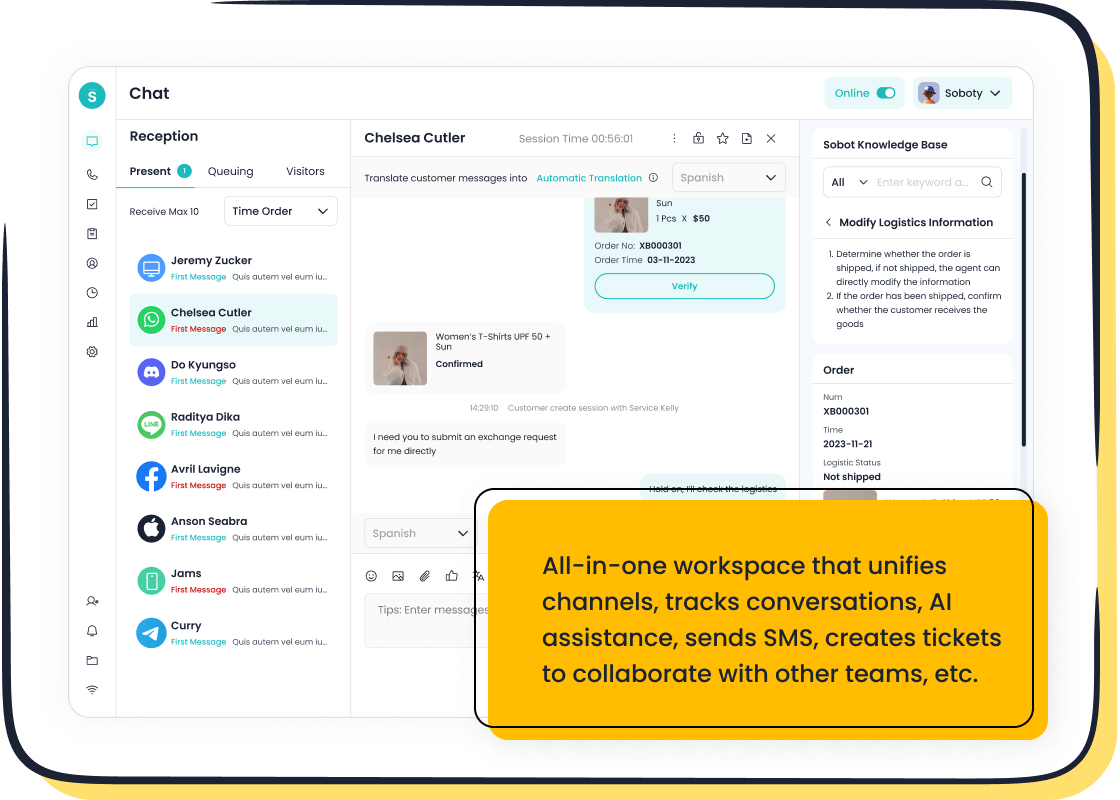Unlock Seamless Multi-Channel Customer Support Experiences

Did you know that 60% of customers report lower satisfaction when forced to navigate multiple channels due to poor design? See the impact below:
| Statistic Description | Value / Impact |
|---|---|
| Customers forced to navigate multiple channels due to complexity or poor design | 60% report lower satisfaction |
| Satisfaction drop when customers call 3+ times to resolve an issue | More than 20 points decrease |
| First contact resolution rate via self-service channels | 41% |
You can unlock seamless multi-channel customer support by integrating all your channels and unifying customer data. This approach gives your team a single view of each customer, enabling consistent, personalized support and higher customer satisfaction. Sobot and Sobot AI provide you with the tools to deliver a seamless experience, ensuring you never miss a chance to support your customers and boost satisfaction.
Multi-Channel Customer Support Essentials

What Is Multi-Channel Support?
You interact with customers on many platforms every day. Multi-channel customer support means you offer customer service through several channels, such as phone, email, live chat, and social media. Each channel stands alone, so your team manages separate conversations on each platform. Customers may need to repeat information when they switch from chat to email or phone. This approach helps you meet customers where they feel most comfortable, but it can create a fragmented experience if you do not connect the channels.
Customers expect quick replies on live chat, detailed answers by email, and fast, friendly help on social media. Younger customers often prefer digital channels, while others still value phone support. When you understand these preferences, you can build a strong customer satisfaction strategy.
To deliver effective multi-channel customer support, you should focus on these essentials:
- Know your customers’ needs and choose the right channels.
- Match your team’s strengths to each channel.
- Build a strong online presence with live chat and social media.
- Share information across channels to avoid repeated questions.
- Use a central knowledge base for both agents and customers.
- Respond to emails quickly to keep customers happy.
- Use technology and automation to manage all channels and improve efficiency.

Sobot helps you unify your customer service channels, making it easier to manage conversations and keep customer satisfaction high. With Sobot Live Chat, you can connect with customers on their favorite platforms and never miss a message.
Why Customer Experience Matters
Customer experience shapes how people feel about your brand. If you deliver great customer service, you build trust and loyalty. One in three customers will leave a brand after just one bad experience, and most will not return after two or three negative interactions (PwC). A strong customer satisfaction strategy helps you keep customers coming back.
- 74% of consumers say they will buy based on experience alone.
- A 5% increase in customer retention can boost profits by up to 95%.
- Customers value quality service more than low prices.
When you focus on customer experience, you encourage repeat business and positive word-of-mouth. You also reduce churn and increase customer lifetime value. Sobot’s multi-channel customer support tools help you deliver consistent, high-quality service, making it easier to meet your customer satisfaction goals.
Channel Integration with Sobot
Unified Customer View
You face many challenges when you manage customer service across multiple channels. You might struggle with campaign coordination, outdated data, and team alignment. These issues can lead to fragmented customer experiences and missed opportunities for proactive customer support. Sobot solves these problems by bringing all your customer service channels together into one unified platform.
Sobot integrates chat, email, phone, SMS, and social media into a single workspace. You can connect with customers on their preferred channels, including WhatsApp, Facebook, Instagram, Telegram, and Discord. This channel integration ensures you never lose track of a conversation, no matter where it starts or ends. Sobot’s unified dashboard gives your agents a complete view of every customer interaction. You see chat history, support tickets, and social media messages in one place. This helps you deliver consistent, high-quality customer service and makes multi-channel customer engagement simple.
Real-time data synchronization keeps customer details, order status, and product information accurate across all channels. You avoid errors, reduce manual work, and build trust with your customers.
Sobot’s platform also connects with your CRM and business systems. This integration lets you automate workflows and personalize every chat or support interaction. You can use AI-powered chatbots to handle common questions, freeing your team to focus on complex issues. With Sobot, you align your teams and democratize customer data, making it easy to deliver proactive customer support at every touchpoint.
Omnichannel Support in Action
Sobot’s omnichannel support goes beyond simple channel integration. You can switch between chat, email, or phone without losing context. The platform uses generative AI to analyze real-time data from every channel. It predicts customer needs and suggests the best next step, whether that’s a chat message, email, or in-app notification. This approach creates seamless multi-channel customer engagement and helps you meet high customer expectations.
Let’s look at a real-world example. Opay, a leading financial service platform, faced challenges managing customer service across social media, email, and voice channels. After adopting Sobot’s omnichannel solution, Opay unified all customer interactions into one system. Agents could view chat, email, and call history in a single dashboard. Sobot’s chatbots handled routine questions, while live agents managed complex cases. Opay also used WhatsApp for targeted marketing and feedback collection. As a result, Opay increased customer satisfaction from 60% to 90%, reduced costs by 20%, and boosted conversion rates by 17%. You can read more about Opay’s success here.
Sobot’s omni-channel customer service workbench supports multi-language and multi-timezone management. You can serve customers around the world, 24/7. The platform’s intelligent routing system directs each chat or support request to the right agent or department. Sentiment analysis helps you prioritize urgent cases and deliver personalized service. Real-time analytics and reporting tools let you track performance and optimize your multi-channel customer engagement strategy.
Tip: Use Sobot’s built-in analytics to measure KPIs across all channels. This helps you identify which chat or support channels drive the best results and where you can improve.
With Sobot, you create a seamless, proactive customer support experience. You reduce churn, increase loyalty, and make every customer feel valued—no matter how they reach out.
Consistent Customer Experience
Brand Voice Across Channels
You build trust and loyalty when your brand voice stays the same on every channel. Customers expect your tone, style, and message to match whether they reach out by phone, email, live chat, or social media. If your voice changes, customers may feel confused or lose confidence in your brand. A strong customer satisfaction strategy starts with a clear brand identity and personality that you show everywhere.
To keep your brand voice consistent, follow these steps:
- Teach your team about your brand values, mission, and voice.
- Train everyone on your style guide and messaging rules.
- Store brand assets and templates in one place for easy access.
- Set up a team to check that all messages match your brand voice.
- Review your content often to fix any mistakes or changes.
- Use tools like AI writing assistants to help keep your tone steady.
- Track engagement and feedback to see how your voice connects with customers.
Customers are 78% more likely to buy from brands that interact with them in a consistent and authentic way. When you use a unified brand voice, you support your customer satisfaction strategy and create a better customer experience.
Sobot helps you maintain your brand voice across all channels. With Sobot Live Chat and omnichannel solutions, you can set templates, automate responses, and monitor conversations to ensure every message reflects your brand.
Service Quality Standards
You need clear standards to deliver excellent customer service on every channel. Industry benchmarks help you measure how well you meet customer needs and support your customer satisfaction strategy. Key performance indicators (KPIs) include Customer Satisfaction Score (CSAT), Net Promoter Score (NPS), First Call Resolution (FCR), and Average Response Time.
| KPI | What It Measures | Why It Matters |
|---|---|---|
| CSAT | Customer happiness with service | Shows if your support meets needs |
| NPS | Customer loyalty and advocacy | Predicts growth and retention |
| FCR | Issues solved on first contact | Reduces effort and boosts loyalty |
| Average Response Time | Speed of replies across channels | Sets customer expectations |
You can use these KPIs to compare your results with industry standards and spot areas for improvement. Companies with strong multi-channel strategies keep 89% of their customers, while those with weak strategies keep only 33% (Aberdeen Group). Sobot’s analytics tools let you track these metrics in real time, helping you adjust your customer satisfaction strategy and deliver an improved customer experience.
Tip: Combine data from surveys, chat logs, and social media to get a full view of your customer service quality. Use this feedback to train your team and update your processes.
With Sobot, you can set service level agreements (SLAs), automate ticket routing, and monitor agent performance. These features help you meet or exceed industry benchmarks and keep your customer satisfaction strategy on track.
Enhance Customer Experience with Personalization
Data-Driven Engagement
You can enhance customer experience by using data to guide every interaction. When you collect and analyze customer preferences, you gain insights that help you deliver the right message at the right time. Many leading companies use data-driven strategies to boost multi-channel customer engagement. For example:
- Uber Eats sends personalized in-app messages and discounts based on what customers like and when they browse, which increases engagement and conversions.
- Aveda uses interactive quizzes to recommend products that fit each customer’s needs, making the experience more personal and satisfying.
- Walmart delivers promotions based on location and customer preferences, creating dynamic content that feels relevant across all channels.
AI-powered tools play a big role in this process. Nearly all businesses now use or plan to use AI to automate and personalize customer interactions (Gartner). With Sobot, you can integrate all your communication channels—social media, email, phone, and chat—into one system. This unified approach helps you maintain context and deliver seamless transitions during the customer journey. You can also use first-party data to tailor content and offers, making every touchpoint meaningful.
Tip: Monitor engagement metrics like response times and satisfaction scores to optimize your multi-channel customer engagement strategy.
Customer Segmentation
Segmenting your customers allows you to enhance customer experience by matching each person with the right support. When you group customers by preferences, needs, or behaviors, you can assign specialists who solve problems faster. This approach leads to more consistent and personalized communication across every channel.
You can use segmentation to:
- Personalize interactions and automate targeted content with AI tools.
- Ensure seamless integration and context for every customer journey.
- Train your team to handle queries on multiple platforms.
- Continuously refine your segmentation to improve multi-channel customer engagement.
Sobot’s omnichannel solution supports customer segmentation by giving you a unified view of each customer. You can track preferences, manage self-service options, and deliver support that fits each stage of the customer journey mapping process. This focus on segmentation improves efficiency, reduces response times, and helps you meet customer preferences for self-service and proactive support.
When you use segmentation, you make every step of the customer journey smoother and more effective. This leads to higher satisfaction and stronger loyalty.
Empowering Teams for Multi-Channel Success
Training and Tools
You empower your customer service team when you invest in the right training and tools. Effective training programs focus on both product knowledge and soft skills. When your team understands your products and learns how to communicate with empathy, you deliver consistent and personalized service across every channel. Regular training helps your agents adapt to changing customer expectations and new technologies.
Many customer-centric companies use interactive training games like the Multi-Channel Mastery Challenge. This game simulates real customer interactions across chat, phone, email, and social media. Your team learns to keep a consistent tone and provide unified service, no matter the channel. Scenario-based exercises let agents handle the same customer across different platforms, building adaptability and confidence.
Tip: Rotate training activities and schedule them regularly to keep your team sharp and engaged.
You also need the right tools for multi-channel customer engagement. Sobot provides a unified workspace where your team can manage chat, email, and social media from one place. With Sobot’s AI-powered chatbots and self-service options, you reduce repetitive tasks and let agents focus on complex issues. Built-in analytics help you track performance and identify best practices for continuous improvement.
Customer-Centric Culture
You build a strong customer-centric culture by making customer needs the center of your business. Leadership commitment sets the tone. When senior leaders champion customer experience, your whole organization follows. Align your company values with customer impact and encourage cross-functional collaboration. This breaks down silos and ensures seamless multi-channel customer engagement.
Here are some best practices to foster a customer-focused mindset:
- Train and empower your team to make customer-focused decisions.
- Integrate customer feedback into your processes for continuous improvement.
- Use technology like Sobot’s CRM and automation tools to enhance personalization and proactive customer support.
- Provide increased accessibility by offering support across chat, email, phone, and self-service channels.
- Monitor satisfaction and adapt your strategies to maintain excellence.
Note: Companies that prioritize customer-centric strategies see higher loyalty and better business results (Forbes).
When you embed these values and processes, you create a culture where every team member feels responsible for delivering great customer service. This approach leads to more effective strategies, better multi-channel customer engagement, and long-term success.
Multi-Channel Customer Engagement Analytics

Feedback Collection
You need to understand what your customers think and feel at every touchpoint. Effective feedback collection is the backbone of strong multi-channel customer engagement. You can use several methods to gather feedback:
- Send email or SMS surveys after a chat or support interaction.
- Use in-app feedback forms and site intercept surveys for instant responses.
- Collect opinions through IVR, phone interviews, or contact forms.
- Monitor social media and email for unsolicited feedback.
- Analyze website and call center data to infer customer sentiment.
You should consolidate all feedback into a centralized system. This approach gives you a complete view of the customer journey and helps you spot trends. Sobot’s analytics tools make it easy to organize, categorize, and visualize feedback from every channel. You can tailor your approach to each platform, ensuring you solicit and act on feedback in ways that fit your customers’ habits.
Tip: Use sentiment analysis and real-time dashboards to track customer emotions and satisfaction. This helps you respond quickly to issues and improve multi-channel customer engagement.
Performance Optimization
You can use analytics to drive better outcomes in multi-channel customer engagement. Sobot’s reporting features let you track key metrics like first contact resolution, average response time, and customer effort score. These insights help you identify friction points and optimize your support strategies.
Here are some best practices for performance optimization:
- Set clear response time goals for each channel and use chat automation to handle simple questions.
- Maintain consistent messaging across all platforms to build trust.
- Gather feedback at every stage of the customer journey to understand needs and pain points.
- Foster a strong knowledge base for self-service, reducing the load on your team.
- Encourage collaboration between sales, marketing, and support teams for a unified experience.
- Adapt to new technologies like AI-powered chatbots for real-time support and hyper-personalization.
You can also use predictive analytics to spot customers at risk of churn and engage them with targeted offers. Sobot’s unified workspace and AI tools help you deliver seamless, personalized support across every channel. By tracking and acting on customer insights, you create a cycle of continuous improvement in multi-channel customer engagement.
| Metric / Insight | Description | Influence on Support Strategy Development |
|---|---|---|
| Customer Effort Score (CES) | Ease of issue resolution | Reduces friction and improves experience |
| Net Promoter Score (NPS) | Customer loyalty | Prioritizes loyal customers |
| User Interaction Patterns | Engagement tracking | Reveals pain points and preferences |
| Behavioral Segmentation | Groups by behavior | Enables personalized support |
| Predictive Analytics | Forecasts needs and churn | Allows proactive, targeted support |
Note: Companies using integrated analytics and best practices in multi-channel customer engagement see higher satisfaction and loyalty rates (Forbes).
You can unlock a seamless experience for your customers by using strategies that focus on integration, consistency, personalization, and analytics.
- Integration across channels builds trust and loyalty, while a consistent brand voice strengthens engagement.
- Personalization, powered by AI, delivers timely support and boosts your customer satisfaction strategy.
- Analytics help you track performance and refine your customer satisfaction strategy for better results.
Sobot’s unified platform supports your customer satisfaction strategy and gives you a competitive edge, as companies with strong omnichannel support retain up to 89% of customers (Forbes). Assess your current setup and see how Sobot can help you lead in customer service.
FAQ
What is multi-channel customer support?
Multi-channel customer support lets you help customers on many platforms, like chat, email, phone, and social media. You meet customers where they are. Sobot’s unified workspace makes it easy to manage all these channels in one place. Learn more.
How does Sobot improve multi-channel customer support?
Sobot connects all your support channels into one dashboard. You see every customer’s history and messages in real time. This unified view helps you give fast, consistent answers. Sobot’s AI tools also automate simple tasks, so your team can focus on complex issues.
Why is a unified customer view important?
A unified customer view gives you all customer data in one place. You avoid repeated questions and lost information. This approach boosts satisfaction and loyalty. Companies using unified data see up to 89% customer retention (Forbes).
Can Sobot help with analytics in multi-channel customer support?
Yes! Sobot’s analytics track key metrics like response time, satisfaction, and conversion rates. You use these insights to improve your multi-channel customer support strategy. Real-time dashboards and reports help you spot trends and make better decisions.
What channels does Sobot support for multi-channel customer support?
Sobot supports websites, apps, WhatsApp, Facebook, Instagram, Telegram, Discord, email, and phone. You reach customers on their favorite platforms. This wide coverage ensures you never miss a message and always deliver seamless multi-channel customer support.
See Also
Expert Techniques To Excel In Live Chat Support
Enhance SaaS Customer Service Using Live Chat Methods
Comprehensive Overview Of Omnichannel Call Center Tools